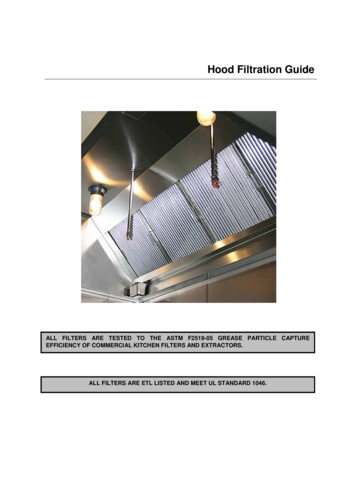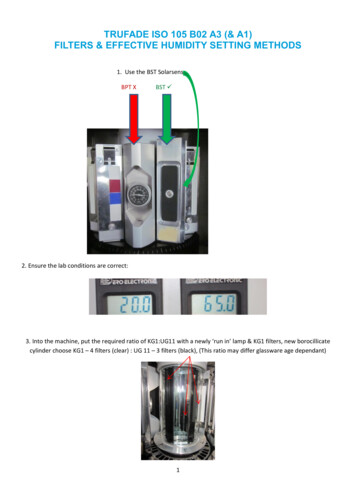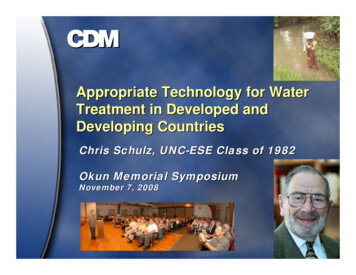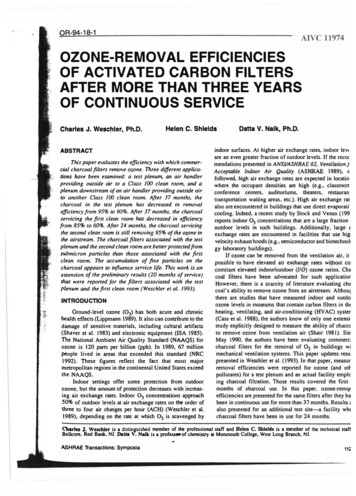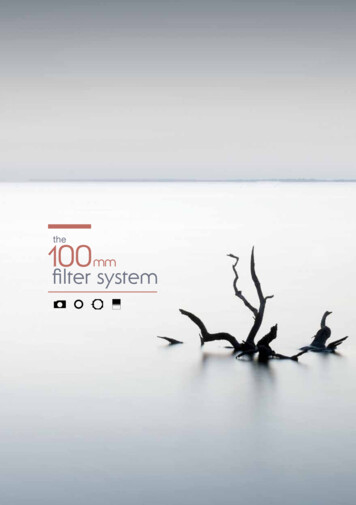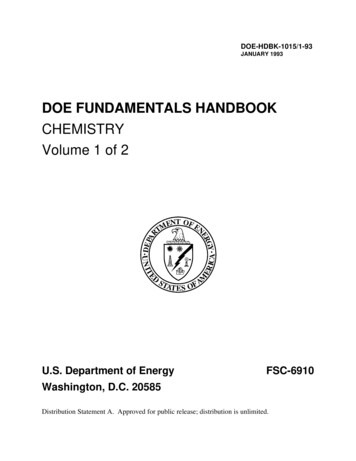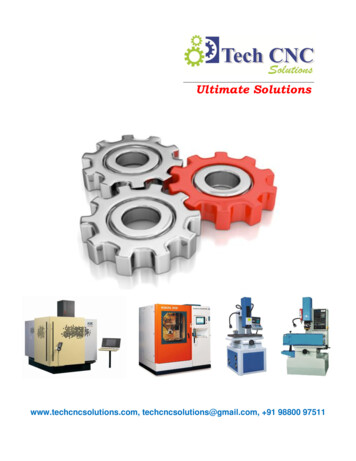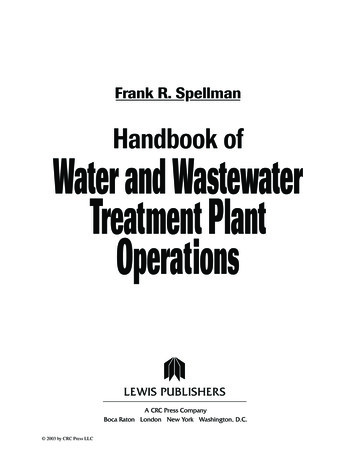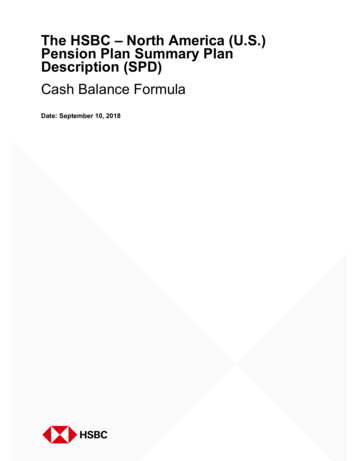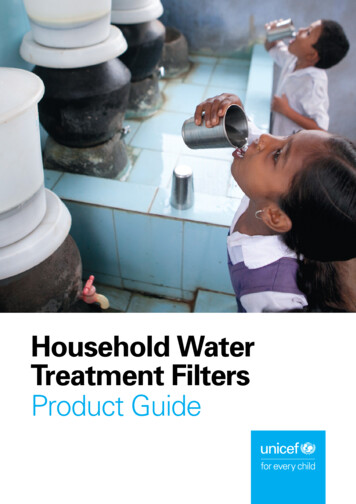
Transcription
Household WaterTreatment FiltersProduct Guide
Table of contents1. Introduction . . . . . . . . . . . . . . . . . . . . . . . . . . . . . . . . . . . . . . . . . . . . . . . . . . . . . . . . . . . . . . . 12. Key parameters . . . . . . . . . . . . . . . . . . . . . . . . . . . . . . . . . . . . . . . . . . . . . . . . . . . . . . . . . . . . 23. Filter categories. . . . . . . . . . . . . . . . . . . . . . . . . . . . . . . . . . . . . . . . . . . . . . . . . . . . . . . . . . . . 44. Validation methods. . . . . . . . . . . . . . . . . . . . . . . . . . . . . . . . . . . . . . . . . . . . . . . . . . . . . . . . . 225. Local procurement. . . . . . . . . . . . . . . . . . . . . . . . . . . . . . . . . . . . . . . . . . . . . . . . . . . . . . . . . 24First edition, April 2020Disclaimer: The use of this product guide is strictly for the internal purposes of the United NationsChildren’s Fund (UNICEF) and in no way warrants, represents or implies that it is a complete andthorough evaluation of any of the products mentioned. This guide does not constitute, and shouldnot be considered as, a certification of any of the products. The models and products included inthis guide are for information purposes only, the lists are not exhaustive, and they do not represent acatalogue of preferred products.This guide is not to be used for commercial purposes or in any manner that suggests, or could beperceived as, an endorsement, preference for, or promotion of, the supplier’s products by UNICEFor the United Nations. UNICEF bears no responsibility whatsoever for any claims, damages orconsequences arising from, or in connection with, the product guide or use of any of the products byany third party.Cover photo: UNICEF/UNI127727/Vishwanathan
1IntroductionThe provision of safe drinking water for all, insufficient quantities, is a key priority for UNICEFand other water, sanitation and hygiene (WASH)actors, be it at the onset of an emergency or ina protracted crisis. With regards to householdlevel water treatment, there exists a wide rangeof options (chlorine tablets, water purifyingsachets, solar disinfection devices and filters,among others), which have been appliedalready, across a range of settings.There is a need for a low-cost and durablehousehold-level solution and, among otherproducts, UNICEF has targeted householdwater filters. However, there is a wide rangeof filter products in the global and localmarket, and it is often challenging to choosethe appropriate product in a given context.Suppliers’ claims are sometimes difficult toproperly evaluate as the products have nothad their performance (effective removal ofbacteria, protozoa and viruses from the water)tested in independent laboratories or havenot been field-trialled to test suitability andacceptability in field conditions. As limited fieldtesting has been carried out for householdwater filters, further field trials could beconducted by UNICEF, as outlined in chapter 4.Product guidance is required to help fieldcolleagues identify the products that are themost appropriate in a given context in termsof performance, ease of use, robustness,acceptability, affordability, durability, logistics andrisks. None of the existing filter technologiesis a perfect and universal solution, with eachhaving its pros and cons that must be evaluated,bearing in mind local considerations.The scope of this product guide is concernsfor household-level water filters, consideringHOUSEHOLD WATER TREATMENT FILTERS PRODUCT GUIDEan average family size of five persons perhousehold. Solar disinfection is discussed in thisguide, as the other main non-chemical methodof water treatment (along with boiling). Waterintake needs are based on the Sphere standardsof 2.5 to 3 L per person per day (survival needs),which leads to the requirement of 5 m3 filteringcapacity for a year of use (see Figure 1).Figure 1. Scope of this product guideNO. OFPERSONSIndividualHouseholdCommunity1520 The filters included in this product guide areall known of by the Supply Division of UNICEFup to Q1 2020. This guide does not present anoverview of all the products that are availableon the market, but looks at the categoriesthat represent the majority of available filters,highlighting a few products in each category.The products highlighted are examplesonly and may require further validation andtesting in the field.The purpose of this product guide is to raiseawareness in regional, country and/or fieldoffices of the different products that areavailable on the market and their specificities,in view of empowering local procurement ofwater filtration products wherever possible.The first part of the guide (chapters 2 to 4) isintended to help WASH colleagues evaluatethe different filter types on the market, whilethe second part (chapter 5) is designed toprovide supply colleagues with an overview oflocal procurement for such products.1
2Key parametersBefore looking at different filter types, itis important to understand the differentparameters to be considered when evaluatinghousehold water filter options. How to validatethese parameters and take them into accountwhen doing local procurement is furtherdeveloped in the following chapters.These parameters were developed by theCentre for Affordable Water and SanitationTechnology1 in 2017 as part of the HumanitarianInnovation Fund Emergency Household WaterFilter Challenge, setting a framework forcomparison of filters. These same parametershave been adopted by the United NationsHumanitarian Response Depot2 as part of itslaboratory evaluation of filters, focusing onease of use and some performance aspects.Understanding the different criteria behindthese parameters allows for a comprehensiveevaluation of the available solutions.The parameters are separated into thefollowing three groups:PerformanceThis relates to the pure performance ofthe filter, without taking into account anyenvironmental or human factors. It of courseincludes protection, which is directly linkedto the quality of the output water, in view ofbeing in line with the Sustainable DevelopmentGoal 6 of universal access to safe andaffordable drinking water for all. But it also looksat other performance parameters, such as flowrate and overall treatment capacity, what kindof raw water can be treated using a specificfilter (turbidity and robustness to turbid waters),or whether safe storage is included to avoidrecontamination of the treated water. Theseparameters are usually checked in laboratoriesfor validation, and are further explained below. Protection: Devices should ensure 99.9%virus protection (3 log removal) and 99.99%bacteria and protozoa protection (4 logremoval). These are the ideal criteria;however, protection-level requirementdepends on setting, context and needs.For example, in some geographical areasviral-related diseases are less prevalentthan bacteria/cyst-related diseases, thustargeted protection against those lattertwo can be acceptable. In emergencies,targeted protection (removal of some andnot all categories of pathogens) might alsobe acceptable, as some level of protection isbetter than no protection at all.For this criterion, independent testingresults should be prioritized overmanufacturer claims. For more informationon log removal, pathogens and their specificsizes, see Table 1 and Figure 2.Table 1. Log removal and equivalencyLog removalEquivalent1 log removal90% removal2 log removal99% removal1Centre for Affordable Water and Sanitation Technology, www.cawst.org/ , accessed 9 July 2020.3 log removal99.9% removal2The United Nations Humanitarian Response Depot (UNHRD)is a network of strategically located hubs for prepositioningrelief items and humanitarian support equipment: The UnitedNations Humanitarian Response Depot, https://unhrd.org/ ,accessed 9 July 2020.4 log removal99.99% removal5 log removal99.999% removaletc.etc.HOUSEHOLD WATER TREATMENT FILTERS PRODUCT GUIDE2
Figure 2. Different pathogens and size Flow rate: The flow rate of the filter product(or time to treat) should be at least 20 L in12 hours (i.e., 1.7 L per hour), with an idealperformance of 0.5 L/min (i.e., 30 L perhour), which allows for water to be poureddirectly into a cup, rather than into a storagecontainer where recontamination can occur. Treatment capacity (lifetime): Thetreatment capacity of filters should be aminimum of 4,500 L to 5,000 L, whichcorresponds to the basic survival needs(2.5 L to 3 L/day as per Sphere standards) ofa family of five over a period of one year. Turbidity: The filter should be ableto treat water that has a turbidity ofover 50 nephelometric turbidity units(NTU) (e.g., a pre-filter is included in theproduct) and reduce it to below 5 NTU atoutput level.Ease of use and acceptabilityThe product must be easy to use andacceptable in order to be efficient, no matterhow performant it is. A recent study showedthat using a water filter for 90% of theconsumed water instead of 100% (due tousability issues, for example) will reduce thehealth gains by 96%, thereby defeating thepurpose of the filter.33Ease of use parameters can be checked inlaboratories and provide some indicationson acceptability, however, only field trials inrelevant settings can provide a clear picture ofthe acceptability of a given product.These parameters include the design ofthe filter, the simplicity of its installation,operation and maintenance, which shouldrequire the minimum amount of trainingpossible (ideally self-sustained through clearand visual instructions) and has a directimpact on its acceptability by end-users. Thedevice itself should be as light and portableas possible, with no disassembly required fortransportation; it should not rely on any externalenergy sources, and should include a fail-safemechanism to avoid continued use when thefilter stops performing (a visual indication, orpreferably a mechanism that prevents thewater from flowing through the filter once ithas reached the end of its lifetime).SustainabilityThis part relates to ‘external’ considerationsof the filter, such as: the filters’ sustainability(they should be durable and have minimalenvironmental impact in terms of materialused, recycling, reuse of parts of the filter, etc.,and require as few consumables as possible,or ideally none at all); their packability to limitshipment volumes and environmental footprint;and their affordability, with a target capital costof less than US 20 per filter for one family.Brown, Joe, and Thomas Clasen, ‘High Adherence IsNecessary to Realize Health Gains From Water QualityInterventions’, PLoS One, vol. 7, no. 5, 7 May 2012, e36735.doi: 10.1371/journal.pone.0036735.HOUSEHOLD WATER TREATMENT FILTERS PRODUCT GUIDE3
3Filter categoriesThere exists a wide range of filter types, interms of filtering material, filtration processesand shapes/design/usability. The maincategories of filters available on the globalmarket are provided and further described(see Table 2). Solar disinfection has alsobeen included, as the other most commonnon-chemical water treatment method(excluding boiling).There is no one-size-fits-all solution, and themost appropriate filter technology will dependon local characteristics and programmerequirements, where acceptability by thetargeted users will be a key consideration(see Table 3).Ceramic filtrationCeramic filters are the most commonly usedfilters at the household level, and have theadvantage of being produced globally at a lowcost, with a wide acceptance in many lowincome countries. Ceramic filters can havepores as small as 0.2 microns, thus removingbacteria and protozoa (but only partly removingviruses), usually with 2 log to 3 log efficiency,while allowing flow that will range from2 L to 15 L, depending on type and numberof filtering elements (2 L to 4 L per singleelement). Ceramic filters sometimes includeactive carbon in their core to remove taste andodour, and/or can be coated or impregnatedwith silver to avoid bacterial growth on theceramic surface.Some ceramic filters come with additives, suchas bromine, that are released in the filteredwater to reportedly remove viruses as well,but this should be considered with care. Theseadditives often have a limited lifetime in termsof efficiency (with no fail-safe mechanism) andtheir efficiency is not yet documented enough.Table 2. Main categories of filters available on the global marketGroupSub-groupCeramic filtrationBucket potBucket candle(s), vertical/horizontalCeramic siphon filterMembrane filtrationand ultrafiltrationGravity filtersPumping filtersScrew-cap filtersOther filtersMulti-step filtersBiosand filtersSolar disinfectionPolyethylene terephthalate (PET) plastic bottles (solar disinfection)Solar bagsHOUSEHOLD WATER TREATMENT FILTERS PRODUCT GUIDE4
Table 3. Comparison of different methods looking at key parametersType of tionFlow rateCapacity/LifetimeSet upO&MSafestorageBucket ceramic potDevelopmentLJLKJJKJBucket ceramic candle(s)DevelopmentLKKKKKJJCeramicsiphon filterDevelopmentKJKJKKLLGravitymembrane filtersDevelopmentKKJKKKLLPumpingmembrane filtersBothKLJJKLLLScrew-capmembrane opmentLJLKKJJJBiosandfiltersDevelopmentLKLJJLKLPET plasticbottles (SODIS)DevelopmentJJJKLLJLJSolar bagsEmergencyJKKLKJLL*Without suction, flow rate is lowHOUSEHOLD WATER TREATMENT FILTERS PRODUCT GUIDE5
Note: It is important to make the distinctionbetween silver coated/impregnatedproducts (which can have a positive impacton water treatment as a secondary product)and silver-based products relying solely oncolloidal silver to disinfect water. The latterare not recommended as a water treatmentsolution following failed certificationduring World Health Organization (WHO)evaluation.4 Such products could giveusers a false sense of safety in terms ofdrinking water quality, while exposingthem to an unacceptable level of risk.the top water recipient to the bottom watercontainer. This can only be found out by visualinspection or by abnormally high flow rate, andin those cases the ceramic component mustbe replaced.CERAMIC FILTERS (BUCKET POT)Description: A ceramic pot is fitted in arecipient above a water container. Water ispoured into the pot and filters by gravity to thelower container, which is equipped with a tapfor distribution. Ceramic pots are sometimescoated with colloidal silver to avoid pathogengrowth/re-growth on the surface of the pot.In the case of ceramic filters, breakage meansnullifying the efficiency of the apparatussince contaminated water would leak from4World Health Organization, ‘International Scheme to EvaluateHousehold Water Treatment Technologies: Results ofRound 1, 2016, www.who.int/water sanitation rt-round-1/en/ ,accessed 9 July 2020.PRODUCT FOCUS PURIFAAYA FILTERDescription: Made in Uganda from local products, it comprises a covered20 L bucket with a tap and handle, with a 10 L silver coated ceramic potfitted in it. Water to be treated is poured into the ceramic pot, filtered bygravity, and clean water is collected in the lower part of the bucket (10 L),ready to be dispensed by the tap.Performance: The Purifaaya filter was evaluated by WHO and certified asproviding targeted protection (1-star rating, with minimum 2 log removalof bacteria and protozoa, less for viruses). Its flow rate is 3–4 L/h and itsexpected lifetime is two years, after which the flow rate decreases.Ease of use/acceptability: The filter is easy to install, operate andmaintain. Maintenance is done by cleaning the pot every two weeks with apiece of cloth and water, as well as the bucket with water and soap.Sustainability: The indicative cost of one filter is 22.6 (0.0025 /L). Noconsumables are required for operation, and the stackable nature of thebucket can allow for lower volume shipment (which remains high overall).The bucket can be reused, if not broken, at the end of the filter’s lifetime.Comparative advantages: Straightforward installation/use, works withturbid water as well.Comparative disadvantages: Limited removal of viruses and high volumefor transport.For more information visit: https://spouts.orgHOUSEHOLD WATER TREATMENT FILTERS PRODUCT GUIDE6
The expected flow rate for this type of filter isusually between 3 and 4 L/h.Some examples of models: Spouts Purifaaya,Filtron Nica.Ceramic pots are mainly manufactured locally– as the risk of breakage occurring is high withinternational transportation – at a low price, andwith an acceptable flow rate and lifetime (atleast two years). In comparison with candles,ceramic pots do not pose a risk of leakage dueto bad installation. No consumables are requiredfor operation and maintenance, and the bucketcan be reused at the end of the filter’s lifetime.CERAMIC FILTERS (BUCKET CANDLE[S])Cleaning of the filter with a brush or a pieceof cloth is required on a regular basis to avoidclogging of the pores, as well as cleaning ofthe bucket for hygiene purposes. Pathogenremoval is generally lower compared withcandles/plates, but is still above 3 log removal(except for viruses).Lifecycle cost: The average cost for this typeof filter for two years is 23.5 (range: 18–30).Description: Ceramiccandle(s) is (are) fixedto the bottom of arecipient (which mustbe properly sealed),to filter water into asafe container usinggravity. The ceramicfiltering element comesin a varied numberof shapes: vertical/horizontal candle(s),dome-shaped, or plate.In some cases, the outlet from the ceramiccandle into the lower container is equippedwith a tube to increase flow, which is normallyexpected to be around 4 L/h.PRODUCT FOCUS KATADYN RAPIDYNDescription: Similar to traditional candle filters with buckets,but with one horizontal candle. Provided without the watercontainers, to be procured locally. It has an option to come asa siphon kit, with a tube fitted to the filter feeding into a cleanwater container.Performance: Microfiltration (0.2 µm pore size) ceramicprovides 5 log removal of bacteria and 3 log removal ofprotozoa, with a flow rate of 2 to 4 L/h and a capacity of20,000 L. Safe storage happens in the lower bucket.Ease of use/acceptability: Very easy to operate,maintenance is done by regularly cleaning the candle – whichacts as a fail-safe mechanism. Installation must be performedcorrectly, otherwise the filter will be inefficient (water leakingfrom recipient to container).Sustainability: Indicative cost per unit is 15 (0.001 /L).Used with local buckets for increased sustainability, the filter fits600 units per pallet. No consumables are required for operation.Comparative advantages: A horizontal candle is placed lowand stays in the water longer with higher water pressure increased flow rate for longer.Comparative disadvantages: Candle is harder to clean for maintenance (especially the lower part).Does not fit any type of bucket, as the bottom diameter needs to be above 25 cm.For more information visit: n-filter-kitHOUSEHOLD WATER TREATMENT FILTERS PRODUCT GUIDE7
PRODUCT FOCUS NAZAVA FILTERSDescription: The Nazava filters use a single ceramic candle, which is eitherfitted on the specially designed structure with recipient and container, oron locally purchased buckets. The dome-shaped ceramic candle, which isimpregnated with silver and filled with activated carbon, can be positionedboth vertically and horizontally.Performance: Nazava filters were tested by the WHO International Schemeto Evaluate Household Water Treatment Technologies, and got a 1-star rating(minimum 2 log removal of bacteria and protozoa, limited for viruses), havinga 2 L/h flow rate and a capacity of 7,000 L.Ease of use/acceptability: Easy to operate, maintenance is done by cleaningthe filter regularly using the brush provided. Filters come with a lifetimeindicator, which acts as a fail-safe mechanism. Installation needs to be donewith care (especially on locally procured buckets) to avoid leakages into theclean water recipient.Sustainability: Indicative price per unit is 14 including the structure ( 4 forthe filter alone/spare filter – 0.0015 /L). Can be used with local buckets forincreased sustainability. No consumables are required for operation (exceptfor changing of the candle).Comparative advantages: Very low price of the filter component, which canbe used on locally procured buckets, and of the complete filter with structure.Comparative disadvantages: Low flow rate and shorter lifetime (7,000 L).For more information visit: www.nazava.com/en/This option has the advantage of being verylow-volume if buckets are procured locally(these should match perfectly), reducingshipment costs. The product lifetime canincrease to five years if it is maintained properlythrough regular cleaning, without the need ofconsumables, and end of life is sometimesmonitored by measuring the diameter of thecandle. Level of performance is higher thanthat of ceramic pots for bacteria and protozoa,but removal of viruses is still limited. Themain risks are the risk of breakage of the filterelement (especially for plates) and the misinstallation of the filter, resulting in leakages.Lifecycle cost: The average cost for this typeof filter for two years is 30.7 (range: 14–65).Some examples of models: Katadyn Rapidynand Gravidyn filter kits, Rainfresh Gravity waterfilter, Berkey candle water filters, Nazava filters,Imerys ImerPure, Tulip Table Top.HOUSEHOLD WATER TREATMENT FILTERS PRODUCT GUIDECERAMIC SIPHON FILTERSDescription: Afilter with a ceramiccomponent isplaced in a waterrecipient (withcontaminatedwater), connectedto a siphon pipethat leads to a cleanwater container– placed 50 cmto 1 m below –and is equippedwith a pumpingcomponent to launch the siphon process(squeezing bulb or equivalent). Expectedflow rate through the filter element is around4–5 L/h. Ceramic filters with a ‘fast-flow’tube connecting the upper and lower water8
PRODUCT FOCUS TULIP SIPHONDescription: The Tulip filter comprises a ceramic filter element (surroundedby a washable pre-filter) and a tube with squeezable rubber bulb and a tap.The filter element is plunged into a container of contaminated water, placedaround 70 cm above a protected recipient for clean water. The bulb operationand siphon pressure forces the water through the hose and into the cleanwater recipient.Performance: The Tulip siphon filter uses the same ceramic componentas the Tulip Table Top, which was evaluated by WHO as providing targetedprotection against bacteria and protozoa (minimum 2 log removal) – 1-starrating. Flow rate is 4–5 L/h, with a total filtration capacity of 7,000 L beforereplacing the filter element.Ease of use/acceptability: The use of this filter requires some amountof training (first treated 20 L must be discarded, rubber bulb needs aspecific level of operation before acceptable flow is reached, filter requiresbackflushing). Maintenance is done by cleaning the pre-filter and brushingthe filter with the provided scrub pad. A fail-safe mechanism is included inthe form of a plastic sensor measuring the diameter of the filter.Sustainability: The cost is 24.5 on average for the filter (0.003 /L). Thefilter is used with local recipients for increased sustainability, and low volumeshipment. No consumables are required for operation.Comparative advantages: Low shipment volume and increased flow ratecompared with gravity ceramic filters. Can be used with any bucket/recipients.Comparative disadvantages: Short lifetime, and limited ease of use requiring training beforedistribution. Asperities in the hose at the bulb level could favour potential re-growth of pathogens.For more information visit: www.basicwaterneeds.com/tulip-siphon/chambers are not part of this category and aregrouped with the ceramic candle filters.Some examples of models: Tulip Siphon,Katadyn Siphon.On top of being lightweight and easilytransportable, this type of filter can be usedwith any two containers (removing the fittingconstraint) and avoids the risk of leakage fromone container to the other. Flow rate is slightlyhigher than for pots/candles, while protectionlevels are similar.Membrane filtration andultrafiltrationThe risk of breaking is still present, and thoughno consumables are required for operationand maintenance, the cleaning process isnot as straightforward as for other ceramicfilters since backwashing is required on aregular basis.Lifecycle cost: The average cost for this typeof filter for two years is 29.7 (range: 14–40).HOUSEHOLD WATER TREATMENT FILTERS PRODUCT GUIDEAlong with ceramic filtration, membranefiltration is the most commonly used methodfor household filtration. The process ofmembrane filtration relies on pores on themembrane surface that are small enough toallow water through, while blocking pathogensthat are bigger in size. Membrane filtrationis split into two main categories – filtrationand ultrafiltration – which depend on the sizeof particles that can be blocked: filtration(including microfiltration) blocks particles of 0.1µm or more, while ultrafiltration blocks particlesof 10 nm to 0.1 µm (see Figure 3).9
Figure 3. Filtration technologies and size of particlesµmFiltrationtechnology:0.0010.01Reverse osmosisUltrafiltrationThe smaller the particles a filter can block, themore efficient it will be at removing pathogensof all sizes, including viruses, from the filteredwater (removing viruses and smaller bacteria isthe main comparative advantage that filtrationmembranes have over ceramic filters). Whileultrafiltration will remove most pathogens,smaller particles such as dissolved salt orsmaller viruses may still pass through. On theother hand, the finer the filter, the harder it willbe for water to flow through it, and in thesecases, additional pressure is often required forthe filtration process to provide an acceptableflow, as opposed to gravity alone. Householdlevel filtration will not remove minerals from thewater, as reverse osmosis is required for this.Regardless of the filter size, membrane filterstend to clog after a while (especially withturbid water), which will lower and eventuallystop the water flow. They therefore need tobe backwashed on a regular basis to maintainan adequate level of performance, andeventually replaced.MEMBRANE GRAVITY FILTERDescription: Gravity membrane filters comein a variety of designs. Some have a structurethat is comparable to that of ceramic table-topfilters, with the recipient and safe container forwater, and the filter element standing in thelower container (with or without tube). Othersare attached at the beginning or end of a tubeof around 1 m, sometimes using the siphoneffect and attached to a hard container or a bag(low shipment volume). Most options do notcome with integrated safe storage. Some areequipped with pre-filter and/or active carboncoating. The pore size varies from 0.1 µm(borderline for ultrafiltration appellation) downto 0.02 µm (at least 4/5 log removal of allHOUSEHOLD WATER TREATMENT FILTERS PRODUCT GUIDE0.11.0101001000MicrofiltrationParticle filtrationpathogens), whichcan efficientlyremove virusesas opposed toceramic filters.Backflushing isrequired (evenmore so in thecase of turbidwater) and is eitherintegrated with apump or can bedone with a syringethrough the pipeor filter element.As installation andmaintenance formembrane filters ismore complicatedthan for ceramicfilters, training ofthe end-user mustbe considered. This type of filter does not usuallyrequire consumables and comes with a lifetimecomparatively higher than that of ceramic filters,if used properly and if replacement cartridges areavailable on the market.Flow rate for this type of filter variesfrom 2.5 to 12 L/h depending on the filterconfiguration and membrane pore size.The risk of leakage is present in some models,in case the filter element or the tube is notproperly fixed to the container with non-treatedwater. There is no fail-safe mechanism in caseof membrane fouling, except abnormally highflow rate.Lifecycle cost: The average cost for thistype of filter for two years is 45.2 (range: 21.3–69.1).10
PRODUCT FOCUS LIFESTRAW FAMILY 1.0Description: This ultrafiltration (0.02 µm pore size) membrane filter comprisesa 2 L reservoir with a pre-filter to remove coarse particles at its bottom,connected to a hose leading to the ultrafiltration hollow fiber membranecartridge and a tap. Water is forced through the filter cartridge by gravity andreleased at the tap. The 2 L reservoir must be hung or suspended abovea storage container. It comes with a bulb for backflushing of the cartridge.LifeStraw Family 2.0 is a tabletop version of the same filter element.Performance: This filter was certified by WHO as providing comprehensiveprotection, with a 3-star rating (minimum 4 log removal of bacteria, protozoaand viruses). The estimated flow rate is 12 L/h when new, and the expectedtotal capacity is 18,000 L. Safe storage must be procured separately.Ease of use/acceptability: This filter is not straightforward in terms ofoperation and maintenance (the user manual is 10 pages long), and training ofend-users is necessary for proper use. Pre-filter cleaning and backflushing arerequired. There is no fail-safe mechanism.Sustainability: The indicative cost for the LifeStraw Family 1.0 filter is 69.09or 0.004 /L. No consumables are required, no power requirement, and it haslow volume for shipment.Comparative advantages: The protection level, flow rate and lifetime of thefilter are high.Comparative disadvantages: Complicated to operate and maintain, which might result in misuse.For more information visit: www.lifestraw.com/PRODUCT FOCUS UZIMA 2.0Description: The Uzima 2.0 filter is a gravity-fed membrane microfiltration(0.1 µm pore size) table-top device. The assembled filter set comprises two20 L buckets stacked on top of each other, the top one for raw water and thelower one for storage of clean water, with the filter cartridge
The scope of this product guide is concerns for household-level water filters, considering an average family size of five persons per household. Solar disinfection is discussed in this guide, as the other main non-chemical method of water treatment (along with boiling). Wate
